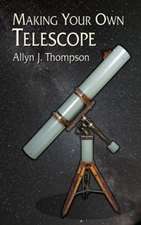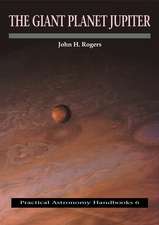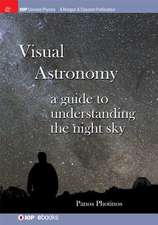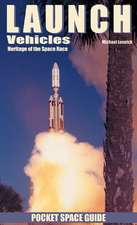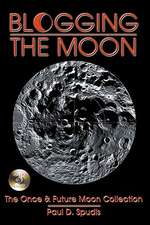Quirky Sides of Scientists: True Tales of Ingenuity and Error from Physics and Astronomy
Autor David R. Topperen Limba Engleză Hardback – 10 iul 2007
| Toate formatele și edițiile | Preț | Express |
|---|---|---|
| Paperback (1) | 217.74 lei 3-5 săpt. | |
| Springer – 29 oct 2010 | 217.74 lei 3-5 săpt. | |
| Hardback (1) | 213.99 lei 3-5 săpt. | |
| Springer – 10 iul 2007 | 213.99 lei 3-5 săpt. |
Preț: 213.99 lei
Nou
Puncte Express: 321
Preț estimativ în valută:
40.95€ • 42.87$ • 33.88£
40.95€ • 42.87$ • 33.88£
Carte disponibilă
Livrare economică 15-29 martie
Preluare comenzi: 021 569.72.76
Specificații
ISBN-13: 9780387710181
ISBN-10: 0387710183
Pagini: 210
Ilustrații: XIV, 210 p. 57 illus.
Dimensiuni: 155 x 235 x 16 mm
Greutate: 0.45 kg
Ediția:2007
Editura: Springer
Colecția Springer
Locul publicării:New York, NY, United States
ISBN-10: 0387710183
Pagini: 210
Ilustrații: XIV, 210 p. 57 illus.
Dimensiuni: 155 x 235 x 16 mm
Greutate: 0.45 kg
Ediția:2007
Editura: Springer
Colecția Springer
Locul publicării:New York, NY, United States
Public țintă
Popular/generalCuprins
Tenacity and Stubbornness: Einstein on Theory and Experiment.- Convergence or Coincidence: Ancient Measurements of the Sun and Moon—How Far?.- The Rationality of Simplicity: Copernicus on Planetary Motion.- The Silence of Scientists: Venus’s Brightness, Earth’s Precession, and the Nebula in Orion.- Progress Through Error: Stars and Quasars—How Big, How Far?.- The Data Fit the Model but the Model is Wrong: Kepler and the Structure of the Cosmos.- Art Illustrates Science: Galileo, a Blemished Moon, and a Parabola of Blood.- Ensnared in Circles: Galileo and the Law of Projectile Motion.- Aesthetics and Holism: Newton on Light, Color, and Music.- Missing One’s Own Discovery Newton and the First Idea of an Artificial Satellite.- A Change of Mind: Newton and the Comet(s?) of 1680 and 1681.- A Well-Nigh Discovery: Einstein and the Expanding Universe.
Recenzii
From the reviews:
"This is a serious work of historical detection, in which Topper delves into the nitty-gritty of astronomical and cosmological theory production from Aristarchus to Einstein. … The extensive list of notes and references at the ends of chapters underline the thoroughness of the research … . I warmly commend this book … ." (Colin Knappitt, Astronomy Now, February, 2008)
"Topper treats us to a series of pen portraits of the intellectual endeavours of Ptolemy, Copernicus, Galileo, Kepler, Newton, and Einstein. … I got a great deal of pleasure from reading this fast-flowing, well-referenced, and refreshingly different book, and I was also introduced to many unfamiliar and thought-provoking aspects of the history of our subject’s progress and the oddities of some of the major proponents of the past." (David W. Hughes, The Observatory, Vol. 128 (1203), 2008)
"The chapters are self-contained, and include treatments of Einstein’s occasional forays into experiment, Galileo’s observations of the motion of sunspots, Newton’s analysis of colour and Kepler’s heroic efforts to account for the planetary orbits by solid geometry. … the book has a certain academic charm. … There are ample consolations here for the specialist, I’m sure … . The author clearly loves this stuff, and his enthusiasm shines through. A reader who already shares that enthusiasm will get along fine with this book … ." (Jon Turney, Times Higher Education, February, 2008)
"This is a serious work of historical detection, in which Topper delves into the nitty-gritty of astronomical and cosmological theory production from Aristarchus to Einstein. … The extensive list of notes and references at the ends of chapters underline the thoroughness of the research … . I warmly commend this book … ." (Colin Knappitt, Astronomy Now, February, 2008)
"Topper treats us to a series of pen portraits of the intellectual endeavours of Ptolemy, Copernicus, Galileo, Kepler, Newton, and Einstein. … I got a great deal of pleasure from reading this fast-flowing, well-referenced, and refreshingly different book, and I was also introduced to many unfamiliar and thought-provoking aspects of the history of our subject’s progress and the oddities of some of the major proponents of the past." (David W. Hughes, The Observatory, Vol. 128 (1203), 2008)
"The chapters are self-contained, and include treatments of Einstein’s occasional forays into experiment, Galileo’s observations of the motion of sunspots, Newton’s analysis of colour and Kepler’s heroic efforts to account for the planetary orbits by solid geometry. … the book has a certain academic charm. … There are ample consolations here for the specialist, I’m sure … . The author clearly loves this stuff, and his enthusiasm shines through. A reader who already shares that enthusiasm will get along fine with this book … ." (Jon Turney, Times Higher Education, February, 2008)
Notă biografică
http://history.uwinnipeg.ca/topper.html
David R. Topper is Professor of History at the University of Winnipeg where, since 1970, he has taught courses in the history of science and the history of art. He was the recipient of two teaching awards: the Robson Memorial Award for Excellence in Teaching at the University of Winnipeg (1981), and the National 3M Teaching Fellowship (1987). Since 1982 he has been an international co-editor and, from 2005, honorary editor of the journal Leonardo. His recent publications are on matters related to the work of Galileo, Newton, and Einstein.
David R. Topper is Professor of History at the University of Winnipeg where, since 1970, he has taught courses in the history of science and the history of art. He was the recipient of two teaching awards: the Robson Memorial Award for Excellence in Teaching at the University of Winnipeg (1981), and the National 3M Teaching Fellowship (1987). Since 1982 he has been an international co-editor and, from 2005, honorary editor of the journal Leonardo. His recent publications are on matters related to the work of Galileo, Newton, and Einstein.
Textul de pe ultima copertă
These historical narratives of scientific behavior reveal the often irrational way scientists arrive at and assess their theories. There are stories of Einstein’s stubbornness leading him to reject a correct interpretation of an experiment and miss an important deduction from his own theory, and Newton missing the important deduction from one of his most celebrated discoveries. Copernicus and Galileo are found surpressing information. A theme running throughout the book is the notion that what is obvious today was not so in the past. Scientists seen in their historical context shatter myths and show them to be less modern than we often like to think of them.
Caracteristici
Clearly demonstrates that the greatest minds throughout history arrived at their famous scientific theories in very unorganized ways. They often did not fully grasp the significance and implications of their own work Outside a circle of specialized academics, these little-known yet fascinating stories are told in a clear and engaging style to captivate the scientific-educated reader Enlightening the reader to the quirkiness of the scientific mind reveals that the popular image of the scientist is really a caricature of the way scientists think and do their work


